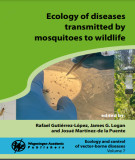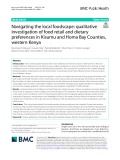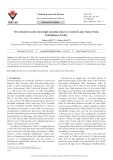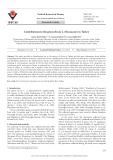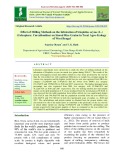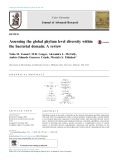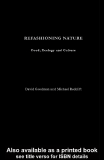
Ecological preferences
-
Part 2 book "Ecology of diseases transmitted by mosquitoes to wildlife" includes content: Consequences of deforestation and habitat degradation on wildlife mosquito-borne diseases, implication of human landscape transformation on mosquito populations, a meta-analytic approach to investigate mosquitoes blood feeding preferences from non-urban to urban environments, surveillance of invasive mosquito species in islands with focus on potential vectors of zoonotic diseases,... and other contents.
 140p
140p  oursky08
oursky08
 01-11-2023
01-11-2023
 5
5
 3
3
 Download
Download
-
Non-communicable diseases have risen markedly over the last decade. A phenomenon that was mainly endemic in high-income countries has now visibly encroached on low and middle-income settings. A major contributor to this is a shift towards unhealthy dietary behavior.
 11p
11p  viferrari
viferrari
 28-11-2022
28-11-2022
 4
4
 2
2
 Download
Download
-
For more than a century, pearly tree frog from its type locality (East Indies; Java; Mt. Wilis) are undiscovered. Current studies about the distribution of Nyctixalus margaritifer are reported as known only from West Java and Central Java. In this paper, we collected one individual of pearly tree frog, N. margaritifer in the Western part of Mt. Wilis, which belongs to Gunung Sigogor Nature Reserve, Ponorogo, East Java. This is the third specimen, which is discovered from the Mt. Wilis after the lost holotype in 1882 and the neotype in 1885.
 6p
6p  dolomite36
dolomite36
 30-12-2021
30-12-2021
 6
6
 0
0
 Download
Download
-
The algal flora of 17 lakes and 1 pond in the Artabel Lakes Nature Park were investigated during two summer seasons (2013 and 2016). In total, 26 desmid taxa were found and identified as new records for the desmid flora of Turkey based on their morphotaxonomic characteristics and ecological preferences. The taxa identified belong to the genera Actinotaenium (1), Closterium (1), Cosmarium (15), Micrasterias (1), Spondylosium (1), Staurastrum (5), Teilingia (1), and Tetmemorus (1). Morphotaxonomy, ecology, and distribution of each species were discussed in detail.
 14p
14p  tudichquannguyet
tudichquannguyet
 29-11-2021
29-11-2021
 5
5
 1
1
 Download
Download
-
This study provides an identification key to the species of Riccia in Turkey and also gives information about detailed morphological and anatomic characters, reproductive forms, detailed photos of Riccia species and their spores, ecological preferences, and distribution patterns in the Mediterranean, Europe, and Southwest Asia. The number of Riccia taxa in Turkey has reached 27 including R. atromarginata, reported for the first time from Turkey in this study. Additionally, the presence of R. gougetiana var. armatissima and R. trabutiana in Turkey is confirmed here.
 45p
45p  tudichquannguyet
tudichquannguyet
 29-11-2021
29-11-2021
 8
8
 1
1
 Download
Download
-
Laboratory experiments were carried out to study the effect of milling methods on the infestation of Sitophilus oryzae on stored rice grains during 2016-17. The results of the present investigation reveals that rubber milled rice were more preferred by the weevils than the iron milled rice with significant differences in weight loss existing among the various rice categories and the highest weight loss per cent was registered from SBA rice category (31.26±0.60 and 33.07±0.62) and the lowest from SMNA rice category (24.47±0.55 and 25.98±0.56) in 2016 and 2017 respectively.
 7p
7p  caygaocaolon7
caygaocaolon7
 18-09-2020
18-09-2020
 9
9
 2
2
 Download
Download
-
not be aptly summarized in a single review. Here, we focus on one aspect of diversity (phylogenetic diversity) in one microbial domain (the Bacteria). We restrict our analysis to the highest taxonomic rank (phylum) and attempt to investigate the extent of global phylum level diversity within the Bacteria. Microbial ecology is the study of microbes in the natural environment and their interactions with each other. Investigating the nature of microorganisms residing within a specific habitat is an extremely important component of microbial ecology.
 14p
14p  trinhthamhodang1
trinhthamhodang1
 16-11-2019
16-11-2019
 20
20
 1
1
 Download
Download
-
We do not always need science to teach us what happens on landscapes, though science enriches that story. All who have had to cope in the world knew this, natives of landscapes wherever. Science brings insight into continu- ing organic, ecological, and evolutionary unity, dynamic genesis; but such unity may also have already been realized by pre-scientific peoples in their inhabiting of a landscape. Science can engage us with landscapes too object- ively, academically, disinterestedly; landscapes are also known in participant encounter, by being embodied in them. ...
 8p
8p  giamdocamnhac
giamdocamnhac
 06-04-2013
06-04-2013
 46
46
 4
4
 Download
Download
-
Consider my parents. My mother did not know any geomorphology or landscape ecology. Yet she enjoyed her familiar, Southern US rural land- scapes. My father enjoyed the fertility of the soils in the Shenandoah Valley in Virginia; he admired a good field. On visits around, he would take a spade and turn the soil to see whether it might make a good garden. He always knew what watershed he was in, what crops were growing where. He loved a good rain. Both enjoyed the changing seasons, the dogwood and redbud in the hills in the spring, the brilliant and subtle colours...
 14p
14p  giamdocamnhac
giamdocamnhac
 06-04-2013
06-04-2013
 63
63
 5
5
 Download
Download
-
The Goodwin-Niering Center for Conservation Biology and Environmental Studies at Connecticut College is a comprehensive, interdisciplinary program that builds on one of the nation’s leading undergraduate environmental studies programs. The Center fosters research, education, and curriculum development aimed at understanding contemporary ecological challenges.
 236p
236p  phoebe75
phoebe75
 01-02-2013
01-02-2013
 49
49
 7
7
 Download
Download
-
Contemporary interest in food is not confined to pleasure in its consumption, but extends in every direction: to its economic importance, the semiotics of food taste, the dangers of food additives and the politics of food security. We live in societies as dominated by food preferences as by sexual preferences, as obsessed about eating too little as by eating too much. In addition our interest in food is associated, for good and evil, with our interest in ‘nature’.
 298p
298p  camchuong_1
camchuong_1
 11-12-2012
11-12-2012
 75
75
 12
12
 Download
Download
CHỦ ĐỀ BẠN MUỐN TÌM








